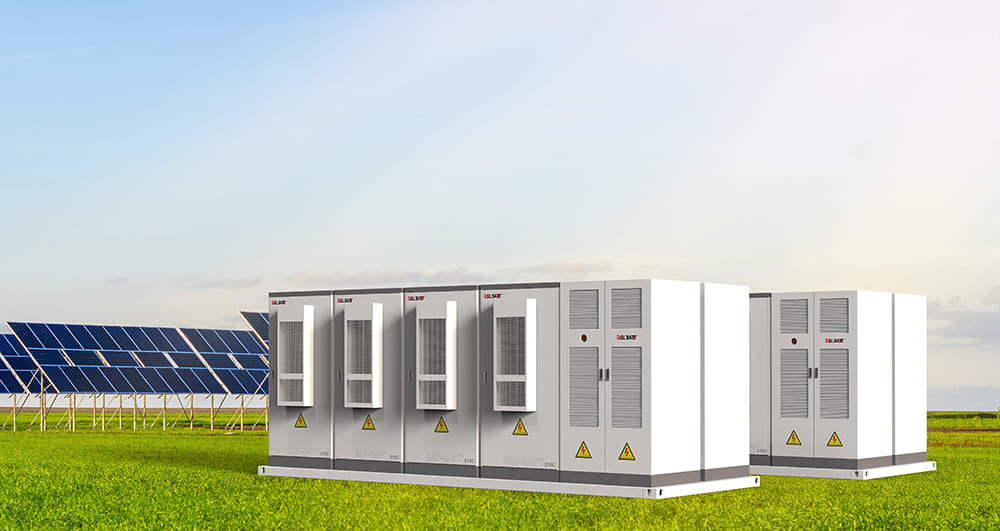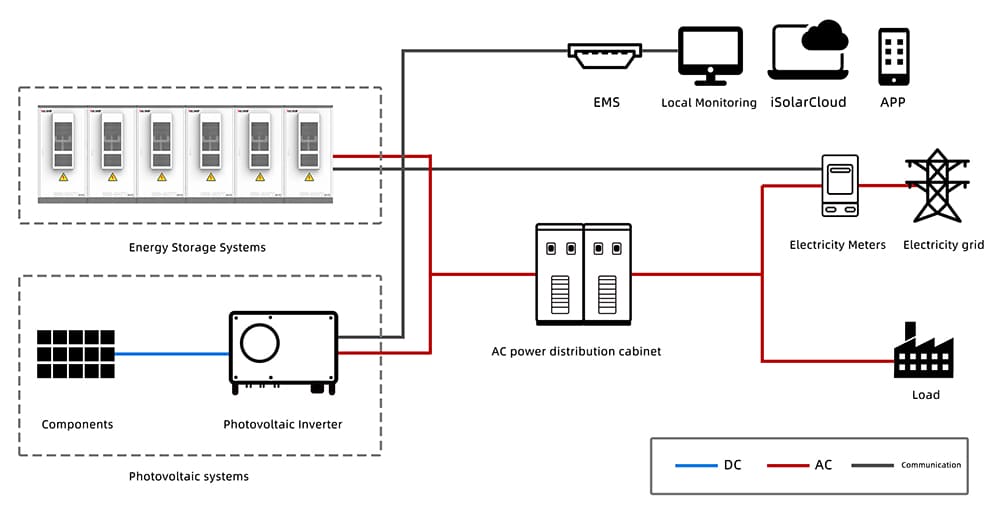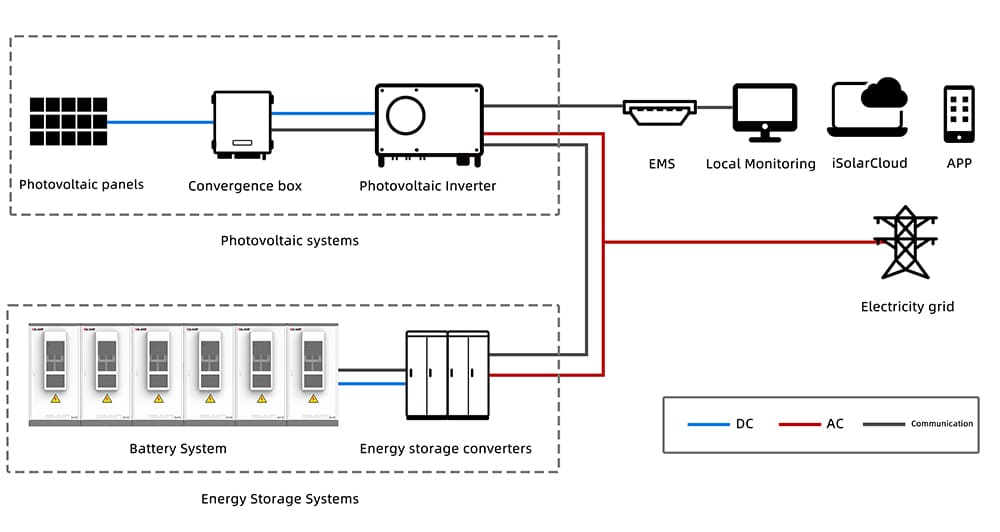A medida que el mundo avanza hacia un futuro energético más sostenible y limpio, los sistemas de almacenamiento de energía se han convertido en un componente crucial de la matriz energética. Entre estos sistemas, el almacenamiento de energía comercial e industrial (C&I) y el almacenamiento en baterías a gran escala son dos soluciones destacadas que han surgido en los últimos años. En este ensayo, exploraremos las diferencias entre estos dos tipos de sistemas de almacenamiento de energía y sus aplicaciones.
El almacenamiento de energía industrial y comercial suele estar integrado y construido en un solo gabinete. Los sistemas de almacenamiento de energía comercial e industrial están diseñados para proporcionar energía de respaldo a instalaciones como edificios comerciales, hospitales y centros de datos. Estos sistemas suelen ser más pequeños que los grandes sistemas de almacenamiento de baterías, con capacidades que van desde unos pocos cientos de kilovatios hasta varios megavatios, y están diseñados para suministrar energía durante periodos cortos, a menudo de hasta varias horas. Los sistemas de almacenamiento de energía comercial e industrial también se utilizan para reducir la demanda de energía durante las horas punta y mejorar la calidad de la energía mediante la regulación del voltaje y el control de frecuencia.Sistemas de almacenamiento de energía C&ISe pueden instalar en el sitio o de forma remota y son cada vez más populares para las instalaciones que buscan reducir los costos de energía y aumentar la resiliencia energética.
En cambio, los grandes sistemas de almacenamiento de energía con baterías están diseñados para almacenar energía procedente de fuentes renovables, como la eólica y la solar. Estos sistemas tienen capacidades de decenas a cientos de megavatios y pueden almacenar energía durante periodos más largos, que van desde unas pocas horas hasta varios días. Se suelen utilizar para proporcionar servicios de red como la reducción de picos de demanda, el equilibrio de carga y la regulación de frecuencia. Los grandes sistemas de almacenamiento con baterías pueden ubicarse cerca de fuentes de energía renovables o de la red eléctrica, según la aplicación, y son cada vez más populares a medida que el mundo avanza hacia una matriz energética más sostenible.
Diagrama de la estructura del sistema de almacenamiento de energía comercial e industrial
Diagrama de la estructura del sistema de la planta de almacenamiento de energía
Almacenamiento de energía comercial e industrial frente a almacenamiento en baterías a gran escala: capacidad
Los sistemas de almacenamiento de energía comerciales e industriales (C&I) suelen tener una capacidad de entre unos pocos cientos de kilovatios (kW) y unos pocos megavatios (MW). Estos sistemas están diseñados para proporcionar energía de respaldo durante periodos cortos, generalmente de hasta unas pocas horas, y para reducir la demanda de energía durante las horas punta. También se utilizan para mejorar la calidad de la energía mediante la regulación del voltaje y el control de frecuencia.
En comparación, los sistemas de almacenamiento de baterías a gran escala tienen una capacidad mucho mayor que los sistemas de almacenamiento de energía comercial e industrial. Suelen tener una capacidad de decenas a cientos de megavatios y están diseñados para almacenar energía procedente de fuentes renovables como la eólica y la solar. Estos sistemas pueden almacenar energía durante periodos más largos, que van desde varias horas hasta varios días, y se utilizan para proporcionar servicios de red como la reducción de picos de demanda, el equilibrio de carga y la regulación de frecuencia.
Almacenamiento de energía comercial e industrial frente a almacenamiento en baterías a gran escala: tamaño
El tamaño físico de los sistemas de almacenamiento de energía C&I suele ser menor que el de los sistemas de almacenamiento de baterías a gran escala. Estos sistemas pueden instalarse in situ o remotamente, y están diseñados para ser compactos y fáciles de integrar en edificios o instalaciones existentes. Por el contrario, los sistemas de almacenamiento de baterías a gran escala requieren más espacio y suelen ubicarse en grandes campos o en edificios especiales diseñados específicamente para albergar las baterías y otros equipos asociados.
La diferencia de tamaño y capacidad entre el almacenamiento de energía comercial e industrial y los sistemas de almacenamiento de baterías a gran escala se debe principalmente a las distintas aplicaciones para las que están diseñados. Los sistemas de almacenamiento de energía comercial e industrial están diseñados para proporcionar energía de respaldo y reducir la demanda energética durante las horas punta de cada instalación. Por el contrario, los sistemas de almacenamiento de baterías a gran escala están diseñados para proporcionar almacenamiento de energía a una escala mucho mayor para facilitar la integración de fuentes de energía renovables en la red eléctrica y proporcionar servicios de red a la comunidad en general.
Almacenamiento de energía comercial e industrial frente a almacenamiento en baterías a gran escala: Baterías
Almacenamiento de energía comercial e industrialUtiliza baterías energéticas. El almacenamiento de energía comercial e industrial requiere un tiempo de respuesta relativamente bajo, y estas baterías se utilizan considerando integralmente el costo, la vida útil, el tiempo de respuesta y otros factores.
Las centrales eléctricas de almacenamiento de energía utilizan baterías de tipo potencia para la regulación de frecuencia. Al igual que el almacenamiento de energía comercial e industrial, la mayoría de las centrales eléctricas de almacenamiento de energía utilizan baterías de tipo potencia. Sin embargo, debido a la necesidad de proporcionar servicios auxiliares de energía, los sistemas de baterías de almacenamiento de energía de las centrales eléctricas de FM tienen una vida útil más larga y requieren un tiempo de respuesta más largo. Para la regulación de frecuencia, se requiere elegir baterías de respaldo de emergencia. Algunas empresas de almacenamiento de energía a escala de red han lanzado sistemas de baterías para centrales eléctricas con tiempos de ciclo que pueden alcanzar aproximadamente 8000 veces, un tiempo superior al de las baterías convencionales.
Almacenamiento de energía comercial e industrial frente a almacenamiento en baterías a gran escala: BMS
El sistema de batería de almacenamiento de energía comercial e industrial puede proporcionar funciones de protección contra sobrecarga, sobredescarga, sobrecorriente, sobretemperatura, subtemperatura, cortocircuito y límite de corriente para elpaquete de bateríasLos sistemas de baterías de almacenamiento de energía comerciales e industriales también pueden proporcionar funciones de ecualización de voltaje durante la carga, configuración de parámetros y monitoreo de datos mediante software de fondo, comunicación con muchos tipos diferentes de PCS y gestión inteligente conjunta de sistemas de almacenamiento de energía.
La planta de almacenamiento de energía presenta una estructura más compleja con la gestión unificada de baterías en capas y niveles. Según las características de cada capa y nivel, la planta calcula y analiza diversos parámetros y el estado operativo de la batería, implementando una gestión eficaz como la ecualización, las alarmas y la protección, para que cada grupo de baterías alcance la misma potencia y garantice que el sistema alcance las mejores condiciones de funcionamiento y la mayor duración. Proporciona información precisa y eficaz sobre la gestión de la batería, mejorando considerablemente la eficiencia de utilización de la energía y optimizando las características de carga mediante la gestión de la ecualización. Al mismo tiempo, maximiza la vida útil de la batería y garantiza la estabilidad, la seguridad y la fiabilidad del sistema de almacenamiento de energía.
Almacenamiento de energía comercial e industrial frente a almacenamiento en baterías a gran escala: PCS
El convertidor de almacenamiento de energía (PCS) es el dispositivo clave entre el dispositivo de almacenamiento de energía y la red eléctrica. En términos relativos, el PCS de almacenamiento de energía comercial e industrial tiene una función relativamente única y es más adaptable. Los inversores de almacenamiento de energía comerciales e industriales se basan en la conversión de corriente bidireccional, su tamaño compacto, su flexibilidad de expansión según las necesidades y su fácil integración con el sistema de baterías; con un amplio rango de voltaje de 150-750 V, pueden satisfacer las necesidades de baterías de plomo-ácido, baterías de litio, baterías de plomo-ácido (LEP) y otras baterías en serie y en paralelo; su carga y descarga unidireccional es compatible con diversos tipos de inversores fotovoltaicos.
La central eléctrica de almacenamiento de energía (PCS) cuenta con función de soporte de red. El convertidor de la central eléctrica de almacenamiento de energía tiene un amplio rango de voltaje de CC, pudiendo operar hasta 1500 V a plena carga. Además de las funciones básicas del convertidor, también cuenta con funciones de soporte de red, como regulación de frecuencia primaria y programación rápida de la carga de la red fuente. La red es altamente adaptable y puede lograr una respuesta de potencia rápida (<30 ms).
Almacenamiento de energía industrial y comercial vs. almacenamiento de baterías a gran escala: EMS
Las funciones de los sistemas EMS de almacenamiento de energía comercial e industrial son más básicas. La mayoría de estos sistemas no requieren despacho de red, solo una gestión energética local eficaz, soporte para la gestión del balance de la batería del sistema de almacenamiento, para garantizar la seguridad operativa, ofrecer una respuesta rápida en milisegundos y lograr una gestión integrada y una regulación centralizada de los equipos del subsistema de almacenamiento de energía.
El sistema EMS de las centrales eléctricas de almacenamiento de energía es más exigente. Además de la función básica de gestión energética, también debe proporcionar una interfaz de despacho de red y una función de gestión energética para el sistema de microrredes. Debe ser compatible con diversos estatutos de comunicación, contar con una interfaz de despacho de energía estándar y ser capaz de gestionar y monitorizar la energía de aplicaciones como la transferencia de energía, la microrred y la regulación de la frecuencia de la energía, así como de monitorizar sistemas complementarios multienergéticos como la fuente, la red, la carga y el almacenamiento.
Almacenamiento de energía industrial y comercial vs. almacenamiento de baterías a gran escala: Aplicaciones
Los sistemas de almacenamiento de energía C&I están diseñados principalmente para aplicaciones de almacenamiento y gestión de energía en el sitio o cerca del sitio, que incluyen:
- Energía de respaldo: Los sistemas de almacenamiento de energía C&I se utilizan para proporcionar energía de respaldo en caso de un corte o fallo en la red. Esto garantiza la continuidad de operaciones críticas, como centros de datos, hospitales y plantas de fabricación.
- Cambio de carga: los sistemas de almacenamiento de energía C&I pueden ayudar a reducir los costos de energía al trasladar el uso de energía de los períodos de máxima demanda a períodos de baja demanda, cuando la energía es más barata.
- Respuesta a la demanda: Los sistemas de almacenamiento de energía C&I se pueden utilizar para reducir la demanda máxima de energía durante períodos de alto consumo de energía, como durante las olas de calor, almacenando energía durante períodos de baja demanda y luego descargándola durante los períodos de máxima demanda.
- Calidad de la energía: Los sistemas de almacenamiento de energía C&I pueden ayudar a mejorar la calidad de la energía al proporcionar regulación de voltaje y control de frecuencia, lo cual es importante para equipos y dispositivos electrónicos sensibles.
Por el contrario, los sistemas de almacenamiento de baterías a gran escala están diseñados para aplicaciones de almacenamiento y gestión de energía a escala de red, que incluyen:
Almacenamiento de energía de fuentes renovables: se utilizan sistemas de almacenamiento de baterías a gran escala para almacenar energía de fuentes renovables, como la energía eólica y solar, que son intermitentes y requieren almacenamiento para proporcionar un suministro de energía constante.
- Reducción de picos de demanda: los sistemas de almacenamiento de baterías a gran escala pueden ayudar a reducir los picos de demanda de energía al descargar la energía almacenada durante los períodos de alta demanda, lo que puede ayudar a evitar la necesidad de costosas plantas de pico que solo se utilizan durante los períodos pico.
- Equilibrio de carga: Los sistemas de almacenamiento de baterías a gran escala pueden ayudar a equilibrar la red almacenando energía durante períodos de baja demanda y descargándola durante períodos de alta demanda, lo que puede ayudar a prevenir cortes de energía y mejorar la estabilidad de la red.
- Regulación de frecuencia: Los sistemas de almacenamiento de baterías a gran escala pueden ayudar a regular la frecuencia de la red al proporcionar o absorber energía para ayudar a mantener una frecuencia constante, lo cual es importante para garantizar la estabilidad de la red.
En conclusión, tanto el almacenamiento de energía comercial e industrial como los sistemas de almacenamiento de baterías a gran escala presentan aplicaciones y ventajas únicas. Los sistemas comerciales e industriales mejoran la calidad de la energía y proporcionan respaldo a las instalaciones, mientras que el almacenamiento a gran escala integra energías renovables y apoya la red eléctrica. La elección del sistema adecuado depende de las necesidades de la aplicación, la duración del almacenamiento y la rentabilidad.
¿Listo para encontrar la mejor solución de almacenamiento para tu proyecto? Contáctanos.BSLBATT¡Para explorar cómo nuestros sistemas de almacenamiento de energía personalizados pueden satisfacer sus necesidades específicas y ayudarlo a lograr una mayor eficiencia energética!
Hora de publicación: 12 de noviembre de 2024











